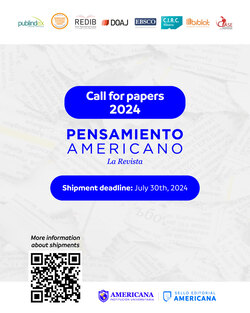Shared disability: a commitment to inclusive deaf-hearing communication from assistive technology
DOI:
https://doi.org/10.21803/penamer.14.28.486Keywords:
Sign language, Assistive Technology, Significant, Disability, Deaf communityAbstract
Introduction: The approach to disability has moved from an individualistic model to a social model whose understanding focuses on the subject-environment interaction; For this reason, the article presented gives an account of a research process that had as its. Objective: to describe the incidence of a translation application of signifiers into Colombian Sign Language
in the deaf-hearing relationship as an inclusive communication strategy in Ibagué (Colombia). Method and/or methodology: it was approached from a mixed descriptive approach and had the participation of ten (10) subjects with hearing disabilities and ten (10) listeners: relatives, teachers and educational peers. Results: From the applied instruments that made reference to the structured interview and the survey, it was found in the latter (on which the results of this document deal), that the application in question has contributed to reducing the communication gaps and the existing social distancing due to the different linguistic codes that each population group uses, revealing a shared disability insofar as deaf and hearing are contextually excluded from the communicative plot due to their interactional differences. Conclusions: the translator of signifiers contributes to the mitigation of traditional communication barriers that for years have marked the deaf and have relegated them to exclusion, where the limitation is not in the language as such but in the primacy of communicative forms. of some (hearing) over others (deaf).
Downloads
References
Albuerne, S y Pino, M. (2013). Apoyo a la comunicación. Mc Graw Hill Education.
Ocampo, A. (2021). Educación inclusiva: interpelaciones al paradigma occidental, nuevas configuraciones onto-epistémicas. RUNAE, 6 (1), 115-130. https://www.aacademica.org/aldo.ocampo.gonzalez/83.pdf
Alisedo, G. (2018). Sordera infantil y educación. Factores de riesgo psicosociolingüístico. Desvalimineto Psicosocial, 5(1). http://dspace.uces.edu.ar:8180/jspui/handle/123456789/4510
Arenas, A., Castellanos, G. y Rojas, J. (2018). Voces del silencio: la inclusión social desde una ruptura en la homogenización comunicativa oyente-sordo. Sciences PI Journal - by Psychology Investigation, II. https://www.sciencespijournal.com/ediciones/2018-volumen-ii/art%C3%ADculo-3/
Bautista, J. E. B., Otavo, J. P., Alba, J. J. B., Páez, M. L. y Riveros, Ó. C. V. (2021). DESARROLLO DE UN APLICATIVO TRADUCTOR PARA LA LENGUA DE SEÑAS COLOMBIANA. Encuentro Internacional de Educación en Ingeniería. https://acofipapers.org/index.php/eiei/article/view/1659
Benvenuto, A. (2004) ¿Cómo hablar de diferencias en un mundo indiferente? La sordera de los oyentes cuando hablan de sordos. Revista internacional de análisis educativo y social De Encuentros 4(8). 84 - 97.
Casado, R. y Lezcano, F. (2012). Educación en la escuela inclusiva. Formación del profesorado y perspectivas del futuro. Grupo Editorial LUMEN.
Castellanos, G. y Montes, J (2021). Traductor de significantes a lengua de señas: La tecnología asistiva como mediadora de la interacción comunicativa sordo-oyente. En Serna, E. (Editor). Ciencia transdisciplinar para el desarrollo y la supervivencia de la humanidad. Editorial Instituto Antioqueño de Investigación. 362-375. https://zenodo.org/record/5139646#.YhZeeS-xCL8
Claros, R. (2004). La Desmitificación de la educación de sordos. Hacia una pedagogía de éxito. Editorial del norte. https://isbn.cloud/9789562919944/la-desmitificacion-de-la-educacion-de-sordos-hacia-una-pedagogia-de-exito/
de Witte, L., Steel, E., Gupta, S., Delgado, V. y Roentgen, U. (2018). Assistive technology provision: towards an international framework for assuring availability and accessibility of affordable high-quality assistive technology. Disability and Rehabilitation: Assistive Technology, 13(5), 467–472. https://doi.org/10.1080/17483107.2018.1470264
Cordero, L. (2018). La comunicación como proceso cultural. Pistas para el análisis. Revista Estudios del Desarrollo Social: Cuba y América Latina, 6(3), e13. http://scielo.sld.cu/scielo.php?script=sci_arttext&pid=S2308-01322018000300013&lng=es&tlng=pt.
García, C. A. (2020). Cultura sorda e inclusión. Avances de investigación, 7(1), 31-41. https://plataformas.ude.edu.uy/revistas/rifedu/index.php/Avanz-Inv/article/view/59/88
González-Montesino, R. H. y Espada, R. M. (2020). Espacios universitarios de aprendizaje inclusivos, bilingües y multimodales: el caso del alumnado sordo signante. Revista De Estilos De Aprendizaje, 13(25), 70–83. http://revistaestilosdeaprendizaje.com/article/view/1519
Hernández, R., Fernández, C. y Baptista, P. (2003). Metodología de la investigación (3ª ed.). Editorial Mc Graw-Hill.
Howard, R., Gathercole, R., Bradley, R., Harper, E., Davis, L., Pank, L., ... y Gray, R. (2021). The effectiveness and cost-effectiveness of assistive technology and telecare for independent living in dementia: a randomised controlled trial. Age and ageing, 50(3), 882-890.
INSOR. (2006). Educación Bilingüe para sordos - Etapa Escolar. Imprenta Nacional de Colombia. http://www.insor.gov.co/home/wpcontent/uploads/filebase/cartilla_etapa_escolar.pdf
INSOR. (2019). Portal INSOR para niños. http://www.insor.gov.co/portalninos/
Mascareño, A. y Carvajal, F. (2015). Los distintos rostros de la inclusión y la exclusión. Revista Cepal. 116. https://repositorio.cepal.org/bitstream/handle/11362/38800/1/RVE116Mascareno_es.pdf
Druetta, J., Massone, M. y Simón, M. (2003). Arquitectura de la escuela de sordos. Libros en red. https://isbn.cloud/9789875610415/arquitectura-de-la-escuela-de-sordos/
Ministerio De Educación Nacional. (MEN). (2006). Orientaciones pedagógicas para la atención educativa de estudiantes sordos. https://discapacidadcolombia.com/index.php/inclusion-educativa/196-orientaciones-generales-para-la-atencion-educativa-de-las-poblaciones-con-discapacidad-en-el-marco-del-derecho-a-la-educacion
Ochoa, C. U., Corredor, M. Y. C. y Bueno, A. C. B. (2020). Salud y educación de niños, niñas y adolescentes con TEA o TDI: una relación simbiótica para su garantía o vulneración. Caso Bucaramanga. Pensamiento Americano, 13(26), 113-126. https://publicaciones.americana.edu.co/index.php/pensamientoamericano/article/view/424/524
Organización Mundial de la Salud (OMS). (2021). Sordera y pérdida de la audición. https://www.who.int/es/news-room/fact-sheets/detail/deafness-and-hearing-loss
Rey, M (2008). El cuerpo en la construcción de la identidad de los sordos. Universidad Nacional de la Plata. https://cultura-sorda.org/wp-content/uploads/2015/03/Rey_CUERPO_CONSTRUCCION_IDENTIDAD-SORDA-2008.pdf
Revuelta, B. y Hernández, R. (2021). Estudios críticos en discapacidad: aportes epistemológicos de un campo plural. Cinta de moebio, (70), 17-33. https://scielo.conicyt.cl/scielo.php?pid=S0717-554X2021000100017&script=sci_arttext
Sacks, O. (1989) Veo una voz. Viaje al mundo de los sordos. Editorial Anagrama.
Smythe, K. C., Adam, D. L., da Silva, C. T. y Okimoto, M. L. L. R. (2019, July). Including Users in the Evaluation Process of Assistive Technology: Applied Methods and Techniques. In International Conference on Applied Human Factors and Ergonomics (pp. 940-947). Springer, Cham. https://link.springer.com/chapter/10.1007/978-3-030-19135-1_92
Smythe K.C.A.S., Adam D.L., da Silva C.T. y Okimoto M.L.L.R. (2020). Including Users in the Evaluation Process of Assistive Technology: Applied Methods and Techniques. In: Ahram T. y Falcão C. (eds) Advances in Usability and User Experience. AHFE 2019. Advances in Intelligent Systems and Computing, vol 972. https://doi.org/10.1007/978-3-030-19135-1_92
Skliar, C., Massone, M. y Veinberg, S. (1995). El acceso de los niños sordos al bilingüismo y al biculturalismo. Cultura sorda. http://escritorioeducacionespecial.educ.ar/datos/recursos/pdf/skliar-massone-veinberg- acceso-ninos-sordos-al-bilinguismo-1995.pdf
Skliar, C. (2007). La pretensión de la diversidad o la diversidad pretenciosa. Ponencia vertida en las 1ras Jornadas Nacionales de Investigación Educativa, Mendoza.
Val, S. (2021). Dejemos de hablar de los sordos. Estudios sordos: activismos, lenguas, 31. http://onteaiken.com.ar/wp-content/uploads/2021/05/5.pdf
Walsh, K. y Mignolo, W. (2018). On decoloniality. Mignolo, D. W. y Walsh, E. C. On Decoloniality Concepts, Analysis, Praxi. http://www.dukeupress.edu/Assets/PubMaterials/978-0-8223-7109-0_601.pdf
Downloads
Published
Versions
- 2021-12-30 (3)
- 2024-05-31 (2)
- 2021-12-30 (1)
Issue
Section
License
Copyright (c) 2021 Pensamiento Americano

This work is licensed under a Creative Commons Attribution-NonCommercial-NoDerivatives 4.0 International License.
The author or authors of an article accepted for publication in the Journal Pensamiento Americano will transfer all of the patrimonial rights to the American University Corporation free of charge, within which are included: the right to edit, publish, reproduce and distribute both print media as digital, in addition to include in article in international indexes and / or databases, likewise, the Editorial Seal is authorized to use the images, tables and / or any graphic material presented in the article for the design of covers or posters from the same magazine. By assuming the patrimonial rights of the article, it may not be partially or totally reproduced in any printed or digital media without its express permission.
AUTHORITY ASPECTS
For the Pensamiento Americano Journal, all the authors of an article have made substantial contributions to the research and the manuscript, and they share the responsibility when the article presents errors, fraud in some way or violations of copyright.
After submitting an article, the journal does not accept the addition, deletion or change in the order of the authors, in addition we reserve the right to release the article when it has been submitted to the journal and under no circumstances will American Thought accept the article. withdrawal of an article during any phase of the editorial process






